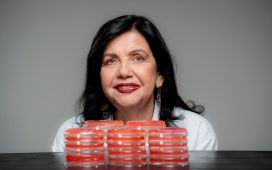Whether it’s a tickle of the nose, or an irritation in one’s hair, itches can be excruciating. Now scientists say they have found a common type of skin bacteria can trigger the sensation.
Crucially, as such bacteria are commonly found on the skin of patients with eczema – or atopic dermatitis – the work helps explain why such conditions can be accompanied by the urge to scratch.
Prof Isaac Chiu, the senior author of the research at Harvard Medical School, said the study – which involved mice as well as human samples and nerve fibres – highlighted that the composition of microbes on our skin was important for our health.
“If we can find ways of inhibiting [itch], especially for patients with chronic itch diseases, that would maybe help improve the lives of these patients,” he added.
The study, published in the journal Cell, details how Chiu and colleagues unpicked the relationship between Staphylococcus aureus – often called staph – and atopic dermatitis, a common itchy skin disease that affects up to 20% of children and 10% of adults.
“Staph is almost always there on these itchy skin lesions,” said Chiu. But, he added: “Nobody’s actually shown that staph can directly cause itch until our study.”
In their first experiments, the team discovered mice with methicillin-resistant Staphylococcus aureus (MRSA) applied to their skin were not only more likely to develop dermatitis than mice without, but scratched far more, and would also feel itchy when touched with a small filament that would not normally cause the sensation. The latter, said Chiu, was similar to how people with eczema might find it excruciating to have a woolly sweater rubbing against their skin.
The team then carried out investigations to explore how the bacteria trigger itchiness. Among the experiments, researchers treated mice with genetically modified forms of MRSA that were unable to produce particular chemicals.
Through a process of elimination, the team unmasked an enzyme called V8 protease as the culprit, and showed that when this substance is injected into mice it causes them to scratch. The team also found skin swabs from human patients with atopic dermatitis contained signs they had higher levels of this enzyme.
Further experiments revealed this enzyme interacts directly with nerve cells that are found in the skin and carry itch signals to the brain, by binding to particular receptors on the neurons. When the team gave mice an anti-clotting drug known to block these receptors elsewhere in the body, the itchiness of the mice subsided.
Chiu said in the future it would be exciting to explore if the drug could be made as a topical cream or ointment to treat itchiness.
While some experts stressed further research was needed in humans, Dr Emma Wedgeworth, a consultant dermatologist and British Skin Foundation spokesperson, welcomed the work.
“Whilst we have previously recognised that staph aureus plays an important role in eczema, its contribution to itch has not previously been recognised,” she said, adding that the study highlighted the pivotal and direct impact of disruptions to the skin microbiome. “Hopefully, this understanding will translate into new treatment options helping to tackle the misery of itch and eczema.”
Joan Geoghegan, a professor in microbiology and infection at the University of Birmingham, agreed: “Armed with this knowledge, researchers may now be able to develop therapies to specifically target the itch-inducing bacterial protease V8, or its target on sensory neurons, to prevent itch and the damage caused by scratching.”










